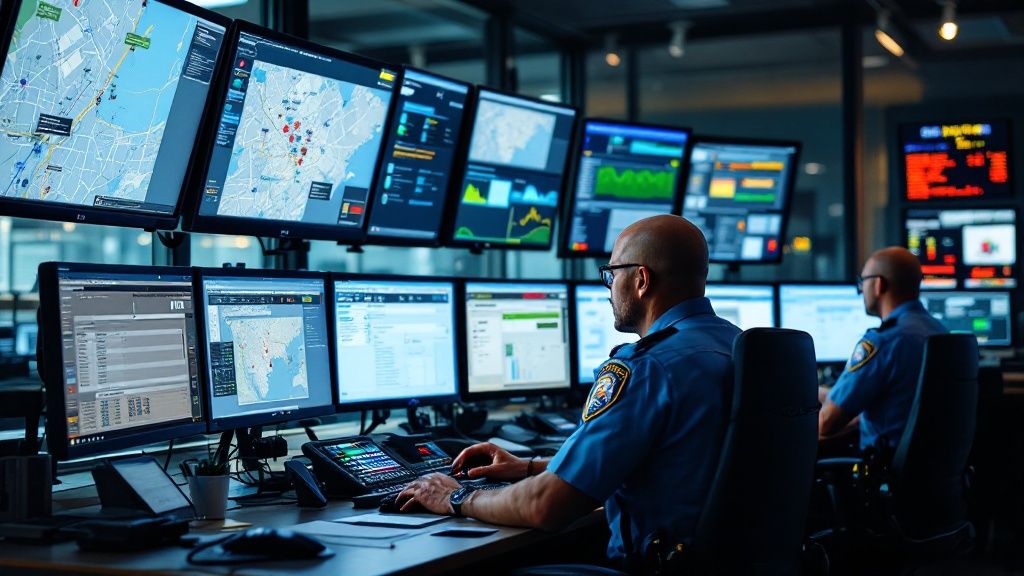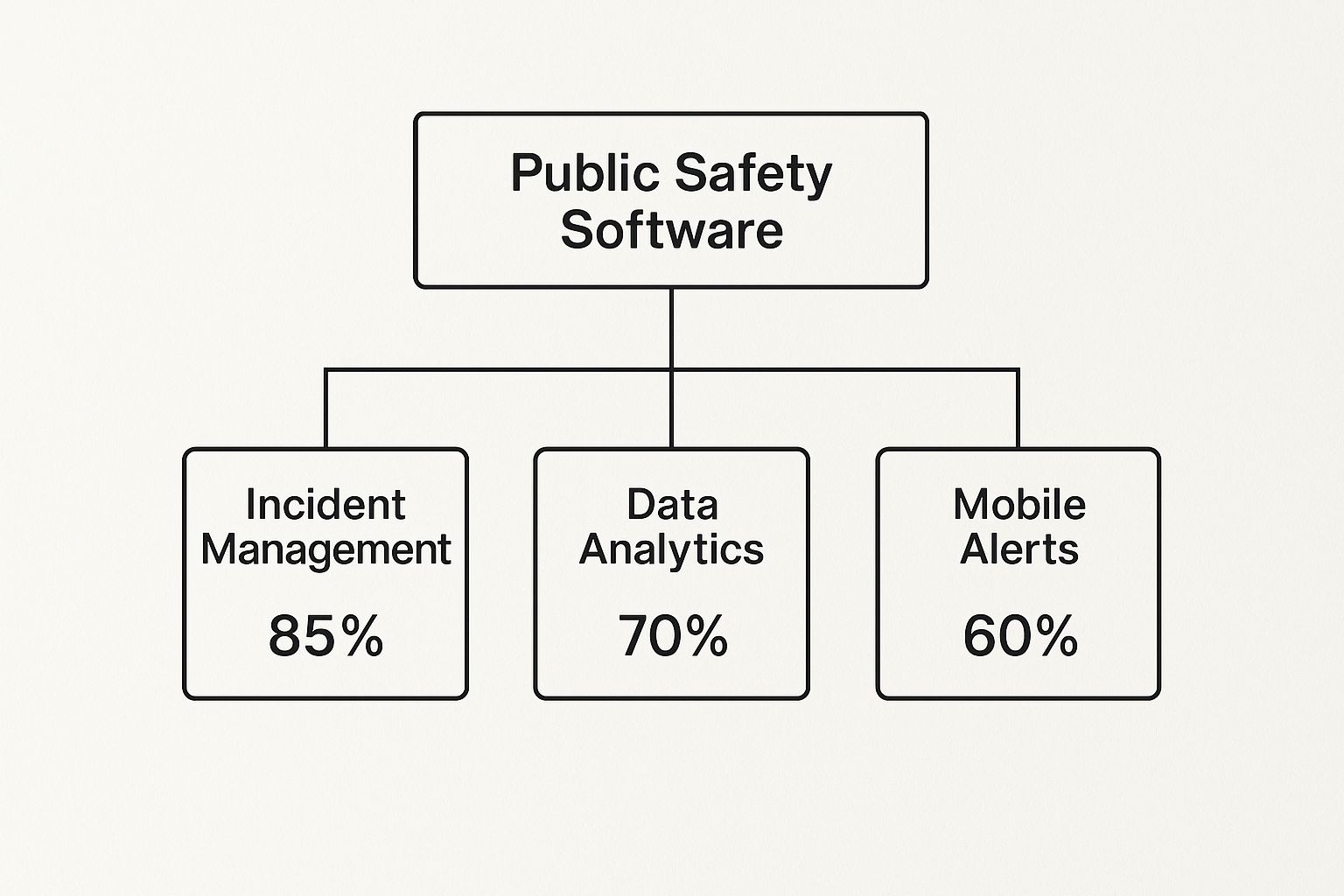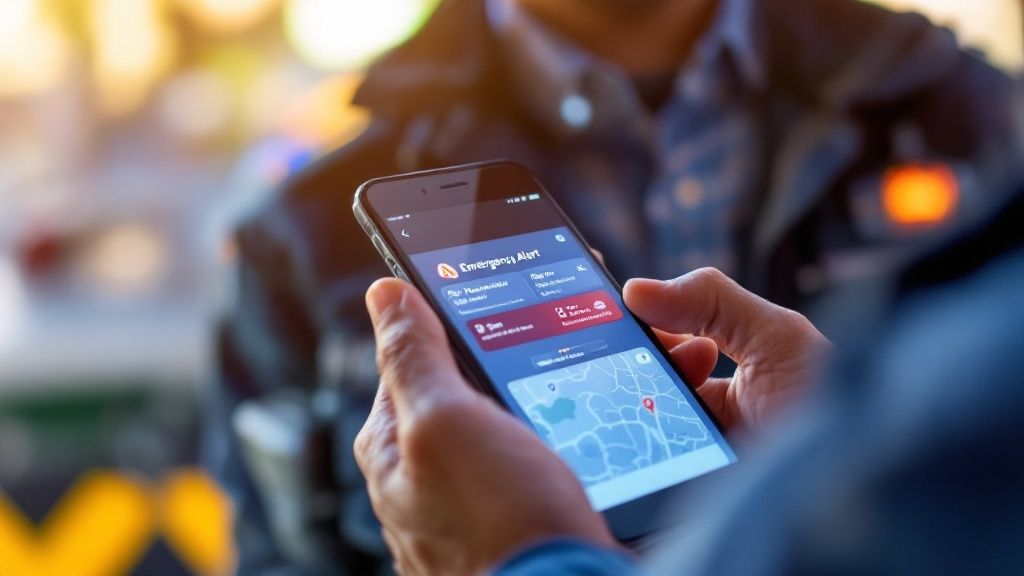Top Public Safety Software for Emergency Response
Think of public safety software as the central nervous system for a community's emergency response. It's what connects police, fire, and EMS into a single, intelligent network. Instead of siloed radio channels and disconnected paper reports, this kind of software creates a unified command center, turning what could be chaotic data into clear, actionable intelligence.
This allows different agencies to coordinate seamlessly, saving critical minutes when it really matters. In this line of work, those minutes can absolutely be the difference between life and death.
What Exactly Is Public Safety Software?

Picture a complex emergency unfolding—say, a multi-car pileup on a busy highway. Without modern software, the coordination effort is a frantic puzzle of radio calls, handwritten notes, and a lot of guesswork. Fire, police, and medical teams are all operating in their own information bubbles, which almost always leads to duplicated efforts and delayed responses.
This is the exact problem that public safety software was built to solve.
At its core, this technology is a digital command center. It integrates every single part of an emergency response, from the initial 911 call all the way through to the final incident report. It breaks down the walls between different agencies, giving everyone a shared, real-time view of the situation as it develops. That shared view ensures everyone is working from the same playbook.
From Radio Chatter to Actionable Data
Let's think about the traditional dispatch process. A call comes in, and a dispatcher manually relays that information over the radio. A Computer-Aided Dispatch (CAD) system—a key piece of any public safety software suite—completely changes that game.
For instance, when a 911 call for a house fire is received, the dispatcher doesn't just get an address. The CAD system instantly:
- Pinpoints the location on a digital map.
- Identifies the closest fire engines and ladder trucks.
- Displays the real-time status of every unit (i.e., available, en route, on scene).
- Suggests the fastest, traffic-aware route to get there.
This kind of automation shaves precious minutes off response times. Instead of first responders asking for directions or dispatchers guessing which unit is closest, the system serves up immediate, data-driven answers.
A key money-saving insight is that optimized dispatching directly reduces operational costs. By sending the closest available unit, a CAD system cuts down on fuel consumption, vehicle mileage, and wear-and-tear across an entire fleet, saving agencies thousands of dollars annually.
More Than Just Dispatch
While dispatch is obviously critical, modern public safety software goes way beyond just handling the initial call. It’s a comprehensive platform for managing the entire lifecycle of an incident, including records management, personnel tracking, and ongoing communication.
Instead of officers having to drive back to the station to file paper reports, they can input data directly from their in-vehicle terminals. That information becomes instantly accessible to detectives, command staff, and other responding agencies. The software can link related incidents, track evidence, and maintain a secure chain of custody, all within one system.
Ultimately, this technology helps shift emergency services from a purely reactive stance to a more proactive and even predictive one. By analyzing historical data and real-time information, agencies can start to anticipate needs, allocate their resources more effectively, and improve outcomes for the entire community. It’s not just about responding faster; it’s about responding smarter.
Decoding Core Software Features
Getting your head around public safety software can feel like a lot, but its real power comes down to a handful of essential features. These are the digital backbone for any first responder agency. Once you understand these core pieces, you start to see how this technology saves time, money, and most importantly, lives.
At the heart of it all are two critical systems: Computer-Aided Dispatch (CAD) and Records Management Systems (RMS).
The Brains of the Operation: Computer-Aided Dispatch (CAD)
Think of a CAD system as the live command center—the brain of the whole operation. When a 911 call hits, the CAD system does more than just log an address. It instantly gets to work analyzing the situation. It pulls up a dynamic map, pinpoints the closest available units with GPS, and maps out the fastest route, all in a matter of seconds.
This immediate, automated intelligence is a total game-changer. It gets rid of the manual guesswork that used to define emergency dispatch, making sure the right people and equipment get to the right place as fast as humanly possible. The result is a quicker, more coordinated response, every single time.
How CAD Makes a Real-World Impact
The financial savings from a good CAD system are direct and surprisingly big. By consistently sending the closest unit, an agency immediately starts cutting down on fuel costs and vehicle wear and tear.
- Here’s a practical example: Imagine a fire department battling a brush fire in a sprawling suburban district. Instead of just relying on radio chatter, the incident commander sees every engine and tanker on a live map. They can reposition resources on the fly to head off the fire's path, minimizing property damage and preventing units from wasting fuel driving to the wrong rally points.
That kind of precision adds up fast. What seems like a simple software feature quickly becomes a serious budget-saving tool over the course of a year.
The image below breaks down which features agencies are investing in, showing a clear trend toward smarter, more data-driven operations.

As you can see, while incident management is almost universal, things like data analytics and mobile alerts are becoming the new standard. Agencies are hungry for better operational intelligence.
The Digital Archive: Records Management (RMS)
If CAD is the brain, then the Records Management System (RMS) is the agency's long-term memory. An RMS is basically a secure, central digital filing cabinet that holds every piece of information tied to an incident. We're talking everything from the initial call notes and officer reports to evidence logs, witness statements, and case files.
A well-run RMS completely changes how an agency works. It replaces mountains of paperwork with a searchable, connected database. This doesn't just make daily tasks easier; it provides priceless data for long-term strategic planning.
Of course, with any software handling sensitive information, you need rock-solid security. That's why a security-first approach and SOC 2 compliance isn't just a nice-to-have—it's essential for protecting data and maintaining trust.
How an RMS Delivers Real Savings
The cost-saving magic of an RMS comes from a huge boost in administrative efficiency. Studies show that officers can spend up to 40% of their shift buried in paperwork. A solid RMS slashes that number, freeing up personnel to be out in the community where they're needed most.
To get a feel for all the moving parts, you can check out a full list of the public safety software features that make this possible.
- Here's how it plays out: A police department rolls out a new RMS that lets officers file reports directly from their in-car laptops. They no longer have to drive back to the station after every call, saving thousands of hours in admin time over a year. Detectives can now instantly search for related incidents across the city, connecting cases that would have taken days of manually sifting through paper reports.
That digital efficiency means you need less administrative staff, and officers get more time for proactive community policing.
The table below gives you a clearer picture of how specific features translate directly into financial benefits for your organization.
Key Features and Their Financial Impact
| Feature | Primary Function | Key Benefit | Practical Money-Saving Example |
|---|---|---|---|
| Computer-Aided Dispatch (CAD) | Automates dispatching and resource allocation. | Faster response times and optimized unit deployment. | Sending the closest unit reduces fuel consumption by 10-15% and lowers vehicle maintenance costs. |
| Records Management System (RMS) | Centralizes all incident and case data digitally. | Drastically reduces administrative time and paperwork. | An officer saves 1-2 hours per shift on reporting, freeing them for patrol and community engagement. |
| Mobile Responder Apps | Provides real-time info to units in the field. | Improves situational awareness and field reporting. | Eliminates the need for expensive, dedicated in-vehicle hardware, saving thousands per vehicle. |
| Personnel & Resource Management | Tracks certifications, availability, and equipment. | Ensures compliance and prevents scheduling gaps. | Automating certification tracking avoids fines and reduces overtime paid for last-minute shift coverage. |
| Data Analytics & Reporting | Visualizes incident trends, response times, and resource usage. | Enables data-driven strategic planning and resource allocation. | Identifying high-incident areas allows for proactive patrols, reducing crime rates and associated costs. |
These features aren't just about fancy tech; they're about making smart, sustainable investments that pay for themselves through increased efficiency and optimized resource use.
The Future of Emergency Response Technology

If you've been in public safety for a while, you remember the old days. Clunky, on-premise servers that cost a fortune to maintain and were a nightmare to update. That world is quickly disappearing. The future is lighter, faster, and a whole lot smarter, all thanks to a huge shift toward agile, cloud-based solutions.
This isn't just about getting rid of the server rack in the closet; it's a completely different way of thinking about your budget. Moving to cloud-based public safety software means you can ditch the massive upfront hardware costs. Instead of a huge capital expense, your agency moves to a predictable subscription, which typically includes all the updates and maintenance. That alone can save thousands in IT overhead and ensures your tools are never obsolete.
From Reactive to Proactive with AI
But the real game-changer? The arrival of artificial intelligence (AI) and machine learning. This is the stuff that’s fundamentally changing how emergency services operate. We're moving from a purely reactive model—waiting for the 911 call—to one that's proactive and even predictive. It’s all about turning mountains of raw data into life-saving intelligence.
AI algorithms can chew through years of data in minutes—historical incident reports, traffic patterns, weather forecasts, you name it—to find patterns a human analyst might never spot. This allows agencies to get ahead of the curve and anticipate where and when incidents are most likely to happen. The industry has taken notice, too. The public safety analytics market was valued at around USD 12.1 billion and is expected to explode to USD 43.1 billion by 2032.
The core benefit here is resource optimization. Instead of guessing where to position patrols or stage ambulances, commanders can make data-driven decisions that put their people in the right place before a call ever comes in. This saves fuel, reduces response times, and prevents staff burnout.
Of course, as AI becomes more integrated into our work, we have to talk about doing it right. There are some major ethical considerations, and it’s on all of us to stay informed. For those interested in the deeper conversation, it's worth reading up on ethical AI development in public safety technology.
Practical Analytics in Action
So, what does this actually look like on the street?
Let's imagine a police department in a mid-sized city is getting hammered by a spike in residential burglaries. The crimes seem random—different neighborhoods, different times of day. It’s a classic whack-a-mole problem.
Using predictive analytics software, they start feeding in data:
- Time of day and day of the week for each incident
- Proximity to major roads and bus stops
- Local event schedules (like high school football games that pull people from their homes)
- Weather conditions
The AI model crunches the numbers and finds something everyone missed. A clear pattern emerges: 70% of the break-ins happen on weekday afternoons, all within a half-mile of specific bus stops, right when most people are at work.
Turning Insights into Savings and Safety
Armed with that specific, actionable intel, the department changes its whole approach. They stop wasting fuel on random patrols and reallocate officers to these newly identified "micro-hotspots" during those peak afternoon hours. Their presence becomes more visible, they can engage with the community, and they’re focusing their efforts where it will actually make a difference.
The results are almost immediate. Within three months, residential burglaries in those targeted areas drop by 40%.
That’s the real power of modern public safety software. It’s not about flashy gadgets or complicated tech for its own sake. It’s about making every dollar in your budget work smarter and turning data into better outcomes that keep your community safe.
How Agencies Win with The Right Software
The real worth of public safety software isn't something you'll find on a feature list or in a slick sales brochure. It's measured in solved crimes, coordinated rescues, and budgets stretched just enough to let agencies do more with less. To really get it, you have to look at the stories of this tech in action—when everything is on the line.
These aren't just hypotheticals. They're real-world examples of how having the right tools helps first responders make smarter, faster decisions that ultimately save lives and protect their communities.
Taming the Storm with Centralized Command
When a hurricane is churning toward the coast, the response is a logistical nightmare. You've got police, fire, EMS, public works, and emergency management all needing to move as one. Without a single, unified platform, that coordination quickly devolves into a mess of chaotic radio chatter and conflicting information.
This is exactly where a centralized command platform becomes the most valuable tool you have.
- Practical Example: During a recent hurricane, a multi-agency command center used its integrated public safety software to orchestrate a massive evacuation. Instead of flying blind, the incident commander had one live map showing the real-time location of every police car, ambulance, and high-water rescue vehicle.
This single source of truth let them dispatch the closest assets to flooded neighborhoods, keep an eye on shelter capacity, and stage resources ahead of the storm's path. It was the difference between chaos and control.
The money-saving angle here is huge. By deploying resources intelligently, agencies kept unnecessary personnel out of harm's way, which slashed overtime pay and fuel costs. On top of that, the precise coordination helped prevent costly damage to emergency vehicles that might have otherwise been swallowed by floodwaters.
Connecting the Dots to Catch a Criminal
In law enforcement, information is everything. Detectives are often drowning in fragmented clues from different incidents, struggling to see the bigger picture. A modern Records Management System (RMS) is the digital thread that ties it all together.
It lets investigators link seemingly random events and spot patterns that would be completely invisible in a world of paper files and spreadsheets.
- Practical Example: Detectives in a large metro area were getting nowhere with a series of burglaries. The method of entry was unique but inconsistent, and the cases were scattered across different precincts with different officers, so no one saw the connection.
Once all the incident reports were digitized into their new RMS, a detective ran a simple keyword search for a specific tool used at just one scene. Boom. The system instantly flagged five other cases across the city with similar, previously overlooked details. By linking these incidents, they ID'd a serial offender and cleared multiple cases with one arrest.
The sheer efficiency of a powerful RMS saves an incredible amount of money by cutting down investigation hours. Fewer hours per case means detectives can manage larger caseloads and solve more crimes without the department needing to hire more people.
Empowering Volunteers to Save a Community
Not every emergency service has a nine-figure budget. For small-town volunteer fire departments, every dollar is precious, and just figuring out who can respond to a call is a constant headache. This is where specialized public safety software becomes an absolute lifeline.
These platforms give volunteer outfits affordable, powerful tools that sharpen response times and ensure a crew is always ready to roll—all without the staggering cost of a fully staffed, 24/7 station.
- Practical Example: A rural volunteer fire department was struggling with inconsistent response times. Dispatch would page everyone out, but it was a guessing game as to who was actually available, leading to dangerous delays. They adopted an app that let volunteers update their status right from their phones.
Now, when a call drops, the chief sees exactly who is available, what their certifications are, and their ETA to the station. That clarity alone has shaved an average of four minutes off their response times. You can see a ton of similar success stories from agencies who have made the jump in the Resgrid Hall of Fame.
For volunteer agencies, this kind of software saves money directly by getting the most out of the people they already have. It means less need for paid standby crews and gives the community a reliable response, all while running on a shoestring budget.
Choosing the Right Public Safety Software

Picking the right public safety software is one of the most critical decisions an agency leader will ever make. This isn't just another IT purchase. It's a long-term investment that will touch every single part of your operations for years to come. Get it wrong, and you're looking at wasted taxpayer money, frustrated personnel, and a system that grinds your daily workflow to a halt.
There's only one way to approach this: methodically. You need to find a true partner, not just a product. That process has to start with a deep, honest look at your agency's actual needs—long before you ever sit through a sales demo. The global market for this software was valued at around USD 10.5 billion and is projected to hit USD 21.2 billion by 2032. That tells you just how many agencies are grappling with these same critical decisions. You can explore more market growth insights about the public safety software industry.
Starting with a Clear Needs Assessment
Before you can even think about evaluating vendors, you have to define what "success" actually looks like for your organization. A thorough needs assessment is completely non-negotiable.
This means you have to get out from behind the desk. Go talk to the people who will be using this software day in and day out: the dispatchers, the officers in the field, the firefighters, the paramedics.
Ask them real questions to uncover the real pain points:
- What are the biggest time-wasters in your current workflow?
- What information do you constantly wish you had in the field but can't get?
- Which of our systems absolutely have to talk to each other for you to do your job?
Here’s a practical example: A fire department's needs assessment reveals that volunteer firefighters are constantly missing calls because their pagers are unreliable. The real, critical need isn't a fancier dispatch screen at the station; it's a mobile app with loud, persistent push notifications. That single insight completely changes what they should be looking for in a new system.
Looking Beyond the Price Tag to Total Cost of Ownership
One of the biggest traps you can fall into is focusing only on the initial sticker price. To understand the true financial impact, you have to look at the Total Cost of Ownership (TCO).
TCO includes the upfront software license plus all the other costs that pop up over its lifespan—implementation, data migration, initial and ongoing training, yearly support contracts, and mandatory future upgrades. A solution that looks cheap at first can quickly become your most expensive option.
When you're calculating TCO, you must demand total transparency from vendors on these often-hidden costs. If a vendor gets cagey about these numbers, that’s a massive red flag.
Verifying Critical Compliance and Interoperability
Your new software can't live on an island. It has to connect seamlessly with the systems you already rely on and meet some very strict security standards.
Two areas are absolutely make-or-break:
- Interoperability: Your new CAD or RMS has to be able to "talk" to your other essential tools, like your state's crime database or a neighboring county's dispatch center. Without that, you're just building another data silo.
- CJIS Compliance: If your agency handles criminal justice information, any cloud-based software you consider must be CJIS compliant. This is a federal standard for data security, and it's not optional. Failing to meet it can lead to serious penalties and losing access to critical FBI databases.
Actionable Money-Saving Insight: Before you even think about writing a Request for Proposal (RFP), create a simple checklist of your "must-have" integrations. Then, during vendor demos, make them prove those integrations actually work. This one step can save you tens of thousands of dollars in "custom development" fees that a vendor might try to tack on after the contract is signed.
Using Pilot Programs to Find the Truth
A slick sales demo can make any software look like the perfect solution. The real test is a pilot program, where you get a small group of your own people to use the software in a real-world setting for 30-60 days. This is where the rubber meets the road.
A pilot program moves beyond promises and shows you how the platform actually holds up under pressure. It's your chance to answer the questions that really matter: Is it actually user-friendly for your team? Does the vendor's support team respond quickly when things go wrong? Does it solve the actual problems you identified in your needs assessment? The feedback you get from your team during this phase is pure gold and should be the final factor in your decision.
Understanding the Vendor Landscape
Trying to find the right public safety software can feel a bit like you're dropped into a massive, sprawling city. You've got the towering skyscrapers on one end—the industry giants like Motorola Solutions and Tyler Technologies. They offer these huge, all-in-one platforms for large, enterprise-level agencies. These systems are incredibly powerful, but they usually come with a hefty price tag and can take a long time to get up and running.
Then you have the nimble street vendors on the other end. These are the more specialized, up-and-coming companies. They tend to focus on solving one or two problems really, really well. Think software specifically designed for volunteer fire departments or smaller police forces that simply don't need a massive, complex system. Getting a handle on this dynamic is the first step to finding a solution that actually fits how you operate and, just as importantly, what you can afford.
Titans Versus Specialists
The choice between a major vendor and a niche provider isn't just about features; it has some serious financial implications. The global public safety software market has hit $7.1 billion, and it's growing fast. The top 10 vendors alone control almost 45% of that market. While industry leaders like Microsoft, Motorola, and Axon have comprehensive platforms, their sheer scale can sometimes mean you get less flexibility. You can see a detailed breakdown in this market share report on top software vendors.
Here’s a practical tip that can save you a lot of money: take a hard look at whether you'll actually use every single feature in an enterprise suite. It's common for agencies to pay for bloated systems when a more focused, less expensive solution from a specialist would meet 95% of their needs at a fraction of the cost.
Aligning Vendors with Your Agency
The real key is to match a vendor's focus with your agency's day-to-day reality. A huge metropolitan police force has completely different security and data management requirements than a rural volunteer ambulance corps.
- Here's a real-world scenario: A small-town fire department looks into a massive software suite from a top-tier vendor. The price is just overwhelming, and they realize half the features are totally irrelevant to them. Instead, they pivot to a specialized provider that focuses on volunteer management and mobile dispatching. The result? They save over 60% on initial costs and aren't stuck paying for a bunch of tools they'll never touch.
This kind of strategic thinking stops you from overspending and makes sure your investment goes into tools that solve your actual problems. It's also critical to look at how vendors handle your data. Understanding public safety software security is absolutely non-negotiable for protecting sensitive information and keeping the trust of your community. Once you know the market, you can negotiate from a much stronger position and find the perfect partner for your team.
Got Questions? We've Got Answers.
Picking out new public safety software is a big move, and it's only natural to have a few questions before you commit. We get it. Here are some straightforward answers to the questions we hear most often from agency leaders trying to make the right call.
How Long Will This Take to Get Up and Running?
Honestly, it varies. The timeline really depends on how complex the software is and the size of your crew, usually landing somewhere between a few weeks and several months.
For example, a volunteer fire department just needing a simple mobile dispatch app could be live in a month. But a multi-precinct police department doing a complete overhaul of their CAD and RMS systems? That’s a bigger project, probably in the six-to-nine-month ballpark.
One of the best money-saving moves you can make is to find a vendor that lets you roll things out in phases. If you can implement one piece at a time—say, mobile dispatch first—you start seeing a return on your investment much faster and avoid the headaches of major operational downtime.
By rolling out new software in stages, agencies can start reaping the financial rewards—like lower fuel costs from better routing—months ahead of schedule, which helps offset the total cost of the project.
Can We Connect New Software to Our Old Systems?
Yes, but you have to be smart about it. Interoperability is the name of the game here. Most modern public safety platforms are built with APIs designed to plug into what you already have, like older record databases or county-wide dispatch networks. The catch? You absolutely have to confirm this during your evaluation.
Here's a practical tip: ask a potential vendor to show you a live integration with a system similar to yours. Don't just take their word for it. Watching it work in real-time can save you from thousands of dollars in surprise custom development fees later on.
Ready to see how a modern, flexible platform can transform your operations without breaking the budget? Check out Resgrid, a unified solution built for first responders that delivers powerful features with no contracts or hidden fees. You can learn more about Resgrid on our website.

